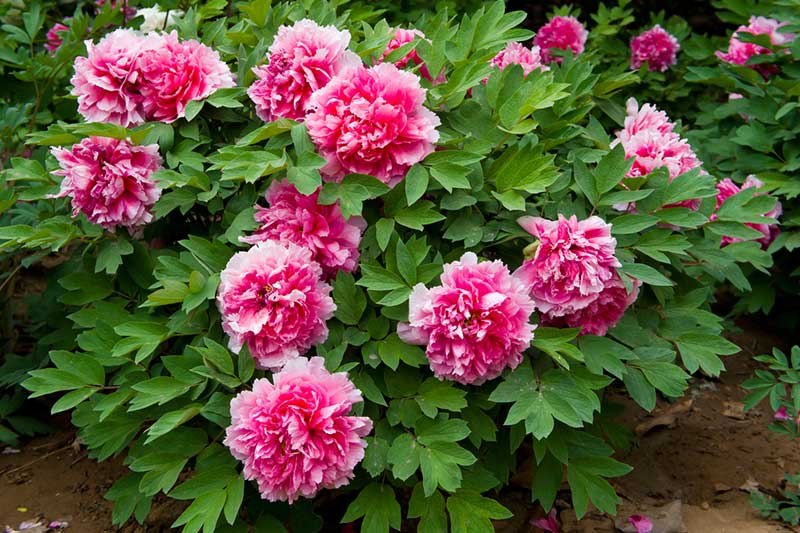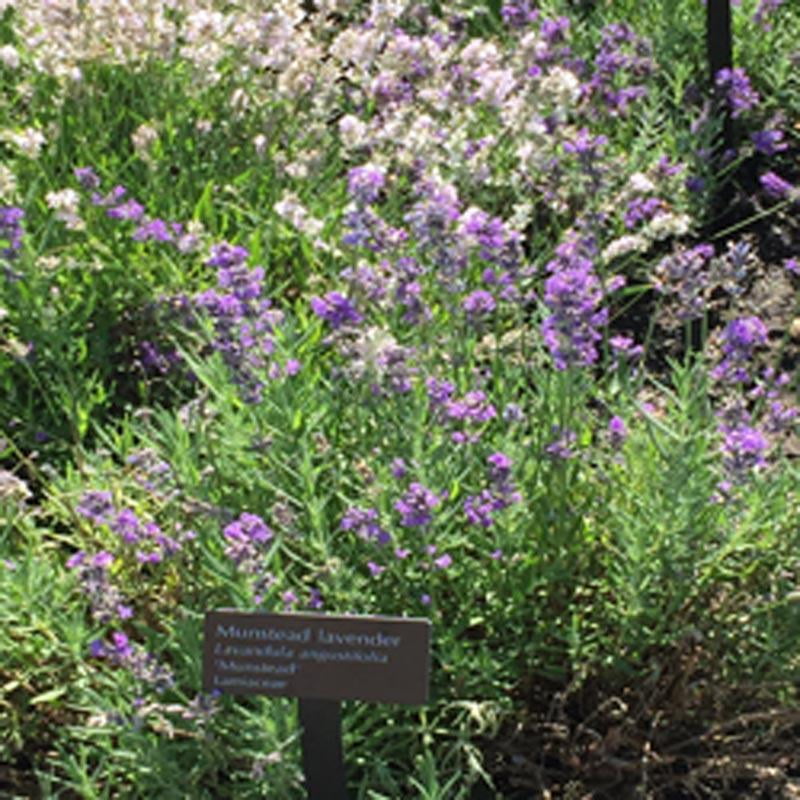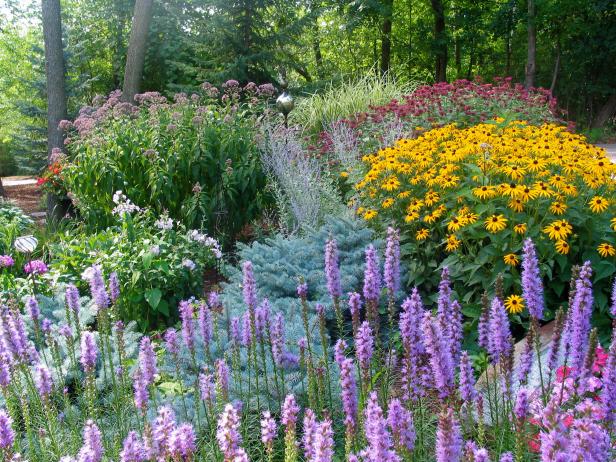Flowers are pale lilac with dark purple spots that appear on upright arching stems in late summer to early fall, when many other plants are beginning to wind down. The flowers are small, so place toad lily in a spot where they can be appreciated up close. The plant grows 2 to 3 feet high and about 2 feet wide, with bright green leaves.
They are excellent for the woodland garden where they will be protected by shade. Toad lily is easy to grow, resistant to deer, somewhat drought tolerant, but grows best in moist soils, even tolerating wet conditions. Several cultivars with varying flower colors are available. Indian pink, also called pinkroot and woodland pinkroot, is a native species to the southeastern U.S. Indian pink is an upright, multi-stemmed clump-forming perennial that is 1 to 2 feet tall and 1 ½ feet wide with bright, glossy green leaves. Numerous flowers appear in late spring/early summer and are tubular, deep red with a contrasting yellow throat that flares at the tip to form five-pointed lobes .
Indian pink grows in part shade to full shade in moist soils, but does really well in full sun and is quite drought tolerant once established. Use Indian pink in a woodland garden, perennial border, rain garden or native garden. Hummingbirds and butterflies are attracted to the beautiful, tubular flowers. Flowers are pale lilac with dark purple spots that appear on upright arching stems late summer to early fall when many other plants are beginning to wind down. Though flowers are quite unique, they are small so place toad lily in a spot where the flowers can be appreciated up close.
The plant grows 2' to 3' high and about 2' wide with bright green leaves. They are excellent for the woodland garden as understory plants where they will be protected by shade. Toad lily is easy to grow, resistant to deer, somewhat drought tolerant, but grow best in moist soils and will even tolerate wet conditions. Switchgrass is native throughout North America and is a dominant species of the tallgrass prairies. It doesn't mind most soils and actually grows well in wet and dry locations. Full sun is the best exposure for switchgrass, but it will grow in part shade; too much shade or rich soils may result in floppy plants.
Switchgrass is a warm-season perennial, growing largely as a bunchgrass 3 to 6 feet tall, but may spread by rhizomes or self-seeding. Flower panicles are open, lacy sprays, with a purplish tint that persist into the winter. Once established, switchgrass is very drought tolerant. It is grown as an accent, in groups or masses and can be effective as a screen.
It also works well in native plant gardens, wild gardens, meadows, naturalized areas, as well as rain, water, and bog gardens. It does not mind most soils and actually grows well in wet and dry locations. Flower panicles are open, lacy sprays, with a purplish tint that persists into the winter. It also works well in native plant gardens, wild gardens, meadows, naturalized areas, as well as rain, water and bog gardens.
Phlox Volcano®is more compact, fragrant and powdery mildew tolerant than other garden phlox types. Flower colors range from red, pink, ruby, white, lavender and purple; flowers may also have eyes of pink, red or white. They can be bicolored such as with 'Lilac Splash.' It does not mind most soils, but needs well-drained soil; irrigate with soaker or drip irrigation to keep foliage dry.
Full sun is the best exposure for Volcano®phlox, but it will grow in part shade. Too much shade and poor air circulation increases chances of mildew developing, though it does not seem to inhibit flowering. It also works well in native plant gardens, wild gardens, meadows, naturalized areas, perennial borders and cottage style gardens. Butterflies and hummingbirds are attracted to the colorful, fragrant flowers. Phlox Volcano® is more compact, fragrant, and powdery mildew tolerant than other garden phlox types.
Flower colors range from red, pink, ruby, white, lavender, and purple; flowers may also have eyes of pink, red, or white or are bicolored such as with Lilac Splash. It doesn't mind most soils, but needs well drained soil; irrigate with soaker or drip irrigation to keep foliage dry. It also works well in native plant gardens, wild gardens, meadows, naturalized areas, perennial borders, and cottage style gardens. Several new, compact forms of glossy abelia are becoming very popular. 'Kaleidoscope' grows 2 to 3 feet high and slightly wider. In spring, leaves appear on bright red stems with lime green centers and bright yellow edges, but variegation does not scorch or burn in hot weather.
In fall, color deepens to shades of orange and fiery red. 'Little Richard' is a 3-foot by 3-foot evergreen, with vivid green leaves in summer, taking on a tangerine-pink color in fall. 'Rose Creek' grows 2 to 3 feet high and 3 to 4 feet wide; it is evergreen with crimson stems. New leaves have a pinkish cast, maturing to lustrous dark green and turn purple in cold weather. Use abelias in containers, as formal or informal hedges, accent plants, in mass plantings or in foundation plantings under windows.
Abelias also attract hummingbirds and butterflies to the garden. Indian pink, also called woodland pinkroot and pinkroot, is a native species to the Southeastern U.S. It is an excellent plant for shady gardens. Indian pink is an upright, multi-stemmed clump forming perennial 1-2 feet tall and 1 ½ feet wide with bright, glossy green leaves. Numerous flowers appear in late spring/early summer and are tubular, deep red with a contrasting yellow throat that flares at the tip to form five pointed lobes . Indian Pink grows in part shade to full shade in moist soils, but does really well in full sun and is quite drought tolerant once established.
Koreanspice viburnum is a small- to medium-sized shrub, offering year round interest. In summer, the leaves are dark green and fall color can be wine-red. Flower buds are pink to red, opening to white or pink in spring and emit a wonderful fragrance. In late summer, clusters of red fruit that fade to black invite birds to the garden. Once the shrub has become established, it is quite heat and drought tolerant. Though it prefers moist, slightly acidic soils, and sun to part shade, it is tolerant of high pH soils and wind-swept conditions.
Vitex is a multi-stemmed large shrub, but can be trained into a small tree. Flowers appear in early summer and continue to bloom sporadically through summer and fall. Flowers of Vitex can be blue, lavender, pink or white. Old strains had small spikes of flowers; improved varieties have large spikes of colorful flowers that are fragrant and make excellent cut flowers. Vitex is not too picky of soils and is easy to grow, very heat, drought and pest tolerant and an excellent choice for a xeric garden. Vitex is often considered an excellent replacement for lilacs, which grow much better in colder climates, and it attracts butterflies and hummingbirds.
Variegated sage green, gold and lime foliage are found on this compact euphorbia that is perfect for containers or a central spot in the perennial garden. Evergreen and drought tolerant, chartreuse yellow flowers with red tips appear in late spring and early summer. This euphorbia looks amazing from spring through fall and even in winter when the plant changes color, getting tinges of pink, red and orange on the leaves. This plant is easy to grow and resistant to disease and pests.
Blue Muffin®viburnum is a small, compact version of the native arrowwood viburnum that grows about 3 to 5 feet high and just as wide. Blue Muffin®prefers moist, well-drained soils, but is adaptable to a wide range of other soils. Established plants are somewhat drought tolerant, have no serious pest problems and require very little maintenance, making them excellent for the urban landscape. Grow Blue Muffin®as a specimen, in groupings, in shrub borders, as a foundation planting or as a hedge.
Firecracker flower is native to India and Sri Lanka, where it is a tropical evergreen subshrub that grows 1 to 3 feet tall. Flowers are apricot to salmon pink in color and form in terminal racemes. Plants bloom throughout the summer and attract pollinators. 'Orange Marmalade' has long-lasting blooms on a plant that thrives with heat and humidity. Large clusters of frilly, bright orange flowers shine against the glossy green foliage.
Firecracker flower prefers light, organically rich, medium moisture, well-drained soils in full sun or part shade, but will tolerate a bright full shade area. Plants thrive in warm, humid weather and have no serious insect or disease problems. Firecracker flower is beautiful in beds, borders, containers or as a houseplant.
Commonly called Brazilian vervain, this plant is a rapid-growing, clump-forming tender perennial. Though a tender perennial, it often grows as an annual in Oklahoma. If planted in sheltered locations with southern exposures, plants can survive mild winters. Even if plants do not survive winter, they often remain in gardens for a number of years through self-seeding.
Plants have no serious insect or disease problems, though watch for powdery mildew. This species is very heat and drought resistant and makes a great cut flower and attracts butterflies and hummingbirds. Improved cultivars include 'Little One,' 'Lollipop' and Meteor Shower®. Interestingly flowering in succession from top to bottom over 4 weeks and more, its button-shaped, purple, rosy red or white flowers resemble blazing stars . Attractive to bees, butterflies and hummingbirds, this beautiful native American enjoys a long season of interest from mid summer to fall and supplies winter bird food.
The narrow, opposite leaves stay attractive all summer and turn a rich bronze in fall. Easy to grow and low care, Liatris spicata adds a strong vertical accent in sunny borders or prairie gardens. It helps create outstanding combinations with the warm golds of Rudbeckia or the purple blossoms of Echinacea. Walker's Low Catmint was the Perennial Plant of the Year in 2007 and is an easy to grow, pest free perennial. This hybrid Nepeta develops into a mound of aromatic, grayish green foliage.
Lavender-blue flowers appear in spring and continue to bloom if properly pruned by trimming after initial flowering. It also tolerates some shade, dry, rocky soil, and is quite drought and deer resistant. Considered to be the most uniform in habit as well as bloom time, Graffiti®comes in several colors including pink, purple, bright red, rose and white. It grows to 16 inches high and 12 inches wide, making it a great plant for containers or in a flower bed.
Graffiti®plants are very heat- and drought-resistant and make great cut flowers. Like all pentas, Graffiti®prefers soil that is not too rich; if it's a bit on the dry side, all the better. Heat, sun and good drainage will have the plants blooming heartily all summer long. Rudbeckia 'Goldsturm' is one of the most popular perennials of all time.
The brilliant gold flowers bloom for months and are beloved by pollinators and beneficial insects.Purple Flame Grass (Miscanthus sinensis 'Purpurascens', zones 3 to 9). Maiden grasses add striking form and texture to the perennial border all summer long. By late summer, many cultivars produce soft, feathery plumes that emerge above the narrow foliage.
Purple Flame Grass is a medium-sized maiden grass, growing three to four-feet tall with foliage that turns from bright green to fiery reddish-orange in early autumn. The attractive plumes are silvery-white and persist on the plants throughout winter. Pruning is only necessary in early spring when the dried foliage and flower stems from the previous season are cut back before the fresh growth emerges. A popular mid-summer bloomer, Moonbeam Coreopsis bears hundreds of small, soft yellow flowers.Astilbe . Astilbe stands out among the longest flowering perennials. Besides being super easy to grow, they thrive in both sunny and shaded gardens, and have feathery flowers that offers months of graceful color.
And speaking of color, the blooms can be white, lavender, purple, bubblegum, deep pink, apricot, or red, often with bronze or purple foliage as well. The plants form tidy clumps with the flower plumes emerging in early to mid summer and persisting into winter. The plants do appreciate ample moisture and regular watering in dry summers can prolong the blooming period.
Outstanding cultivars include 'Bridal Veil', 'Pumila', and 'Fanal'. This lovely tall salvia produces large, deep blue flowers on long green stems from mid-summer to frost. Reaching 6 feet tall, Salvia guaranitica is perfect for garden beds and borders, cutting gardens, containers and for attracting hummingbirds and butterflies. Preferring moist and well-drained soil it is also drought tolerant and low maintenance once established. Salvia 'Amistad' is a recently introduced Salvia guaranitica that is receiving acclaim. More compact in stature, it has dark purple flowers that emerge out of a nearly black calyx.
Bush clovers are hardy, semi-woody deciduous shrubs reaching 4 to 6 feet high and at least as wide with arching stems. In harsh winters, it can die to the ground, but quickly comes back the following spring. Late winter or early spring pruning may be necessary to rejuvenate the plant. Flowers develop on new wood and are rosy-purple in late summer to early fall, completely covering the plant. Bush clovers perform well in sandy, infertile soil and are very drought tolerant once established; ideal drainage is essential. 'Little Volcano,' a selection from Japan, is more upright with dark green foliage and red-purple flowers.
'Gibraltar' is a spectacular selection with long, arching stems also covered in rosy-purple flowers from late summer to early fall. Annual vinca, which also goes by Madagascar periwinkle and other common names. Annual vinca tolerates the heat and humidity of the southwest.
It is tolerant of low fertility soils and is drought tolerant. Full sun and warm soil temperature is required for this species to thrive. Annual vinca is subject to chill injury, which predispose them to root diseases. Flower colors come in shades of white, pink, red and purple. Plants grow 6 to 12 inches tall and 8 to 24 inches wide, depending on cultivar.
Improved cultivars provide an abundance of flowers on stocky plants and disease resistance, which is very important with this species. Improved cultivars include plants in the Cora® series, Mediterranean series, Titan™ series and many others. Vigorous, carefree, good-looking, with a season of interest lasting more than 6 months, who could resist? Gradually, these densely clustered buds reveal tiny, star-like flowers, in shades of white, pink or red, in late summer or early fall.



























No comments:
Post a Comment
Note: Only a member of this blog may post a comment.